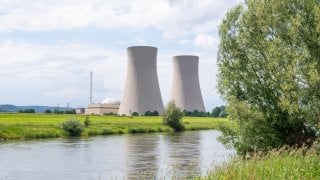The Nuclear Power Challenge
The greatest obstacle to the most reliable clean energy source is misplaced public fear and lack of understanding.
In my previous article, I described how the growth of artificial intelligence and cryptocurrency means that data centers require access to evermore quantities of reliable energy to power them. A quick glance at the electrical generation capacity of North America, much of Europe, and Asia leads you to a simple conclusion: more generation capacity—and cleaner generation capacity at that—is needed.
Currently, 3.5 percent of the world’s carbon emissions are the result of power consumption by data centers. Data centers need a consistent power that solar and wind simply cannot guarantee. A stable 24/7 capacity can only be provided by relying on fossil fuels, hydroelectric and geothermal power, or nuclear energy. Burning more fossil fuels for power generation is not an option. Of the remaining “green” options, geothermal and hydroelectric power are only feasible in a few select geographic regions, leaving us with nuclear power as the only real choice to power the lion’s share of the massive growth expected in data centers around the world, not to mention the general surge in the world’s energy needs.
Politically, nuclear power is a sensitive issue in the West, with many voters’ perceptions of nuclear power shaped by the frightening scenes of the Chernobyl and Fukushima disasters. Yet, Western countries continue to push new climate initiatives that require increased electrical generation capacity, whether electric vehicle mandates or fossil fuel heating phaseouts.
Noticeably missing from these initiatives are realistic plans to address the electricity generation needs of the country. Most experts agree that nuclear power has to be part of a green solution. More troubling is that adversaries of the West are building nuclear power stations at a blinding pace in order to secure their energy future. Yet, in the West, our grid is being overtaxed, and even traditionally secure sources of generation capacity are faltering. For instance, due to climate shifts, Canada’s prized hydroelectric power industry is failing to produce enough electricity, leaving Canada to import electricity from the United States for the first time in a decade. This is a less-than-ideal position for a country with a long history of selling its cheap surplus electricity, and it also raises questions about the ability of non-nuclear green sources to produce the energy needed.
The West is slowly waking up to this reality, with leaders at the COP 28 summit calling nuclear power the only viable option to attain their carbon reduction goals, culminating in an agreement by twenty-five countries, including the United States, to triple nuclear generation capacity by 2050. Development efforts between GE and Hitachi are leading to safer and cheaper reactors, and plans to build them in the West are beginning to gain steam, though few boots and shovels have struck dirt. Perhaps a symptom of general bureaucracy that has come to plague large infrastructure projects, but more likely a sign nuclear power still lacks the general social acceptance for wide-scale expansion.
Uranium price and supply challenges threaten to ground these efforts, further spooking investors away from nuclear reactor construction projects and their prohibitively long payback periods. Yet these challenges have had the upside of aiding fledgling domestic producers in the United States to gain market share. Congress has moved further to secure domestic production with the passage of HR. 1042, uranium imports from Russia, a significant producer of power station-grade enriched uranium, were banned. These steps help secure future energy security for the United States in the same way that our oil and gas production currently does.
With public acceptance being the largest roadblock to the implementation of nuclear power on the scale needed to meet energy needs, education, and communication need to be paramount for our leaders. For a large majority of the public, there is no understanding of nuclear fission or radiation, seeing it as some type of invisible, dangerous alchemy. As such, the disposal of nuclear waste is highly unnerving to a public that is terrified of nuclear waste due to misconceptions born out of the media’s depictions of radiation and nuclear disasters. With a more informed understanding of the risks and benefits of nuclear power, I believe that public opinion would largely be in favor of nuclear power.
Clean, safe, and reliable nuclear power is not only needed but very attainable if we focus on education and public investment in the technology.
Adrian Kranz is president of Paratrade Corporation and a contributing writer for the Newport Global Summit.
Image: Wlad74 / Shutterstock.com.

